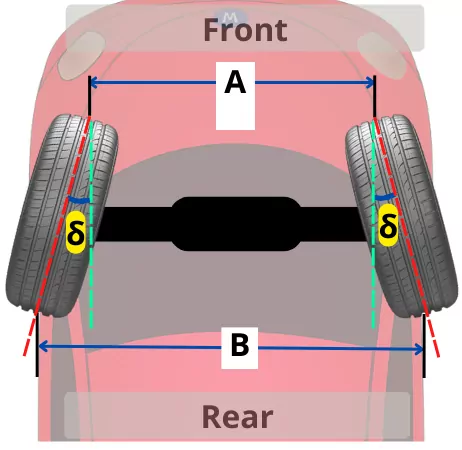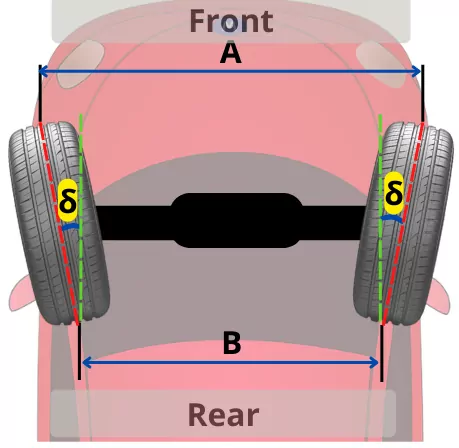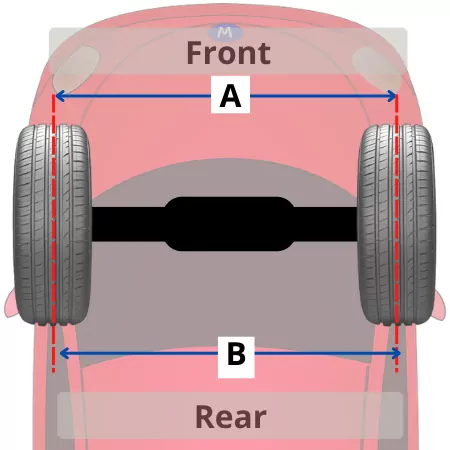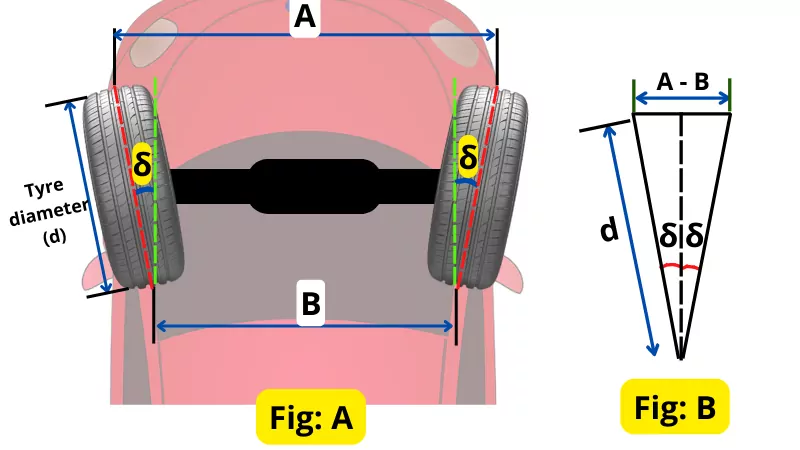The three main adjustments used during wheel alignments are toe (toe-zero, toe-in and toe-out), caster and camber angle. Now in this article, we are going into great detail about one of the key alignment factors, toe and its types.
In this article, we’re going to discuss:
- What is Toe-in and Toe-out?
- Effects of toe-in:
- Effects of toe-out:
- How to measure a toe-in and toe-out?
- Difference between Toe-in and Toe-out:
- Advantages of toe-in:
- Disadvantages of toe-in:
- Advantages of toe-out:
- Disadvantages of toe-out:
- FAQs:
What is Toe-in and Toe-out?
The term toe indicates the alignment of the wheel axis with respect to the longitude axis of the vehicle (Viewing from the top). The toe is measured in terms of distance or as angle.
It is classified further as follows:
Toe-in:
The toe-in says that the front ends of the wheels are pointing toward the central axis of the vehicle. In a toe-in situation, the wheels are closer to each other at the front end than at the rear end.
Thus, the toe-in indicates the distance by which the front ends of the wheels are closer than the rear ends.

Thus from the above figure, the toe-in is given by,
Toe-in = B – A
Toe-out:
The toe-out indicates that the front ends of the wheels are pointing away from the central axis of the vehicle. In a toe-out situation, the wheels are closer at the rear end.

Thus, the toe-out indicates the distance by which the front ends of the wheels are away from each other than the rear ends.
Thus, the toe-out is given by,
Toe-out = A – B
Zero toe:

When the front end of the wheel is neither pointing inward nor pointing outward then such a condition is known as zero-toe.
In this case, while viewing from the top, the distance between the front ends of the wheels is equal to the distance between the rear end of the same wheels.
A = B
With the zero-toe adjustment, the car is more stable to move in a straight line at high speed.
Effects of toe-in:
The toe-in has following effects:
- Toe-in causes increases in slip angle of tires which helps to increase the grip between tire and road.
- The toe-in helps to minimize the cone rolling effects caused due to the camber.
- In the case of engine-driven wheels, the increase in toe-in angle helps to accelerate the automobile faster.
- In the case of wheels that are not driven by the engine, the increased grip due to the toe-in angle offers resistance to the vehicle motion and reduces the acceleration of the vehicle.
- The top speed of the vehicle also decreases with an increase in the toe-in angle.
- In this case, the driver has to put more steering effort to turn the vehicle.
- The vehicle with a toe-in angle is more stable on high-speed corners. It helps to overcome the oversteer effects.
- Due to the increased slip angle, the stress on the tire increases which decreases the life of the tires.
- The increased grip due to toe-in causes the tyres to heat up faster.
- The incorrectly set toe-in angle increases the wear rate of the tyre.
Effects of toe-out:
The toe-out has following effects:
- The toe-out also increases the slip angle of the tyre which increases the grip between the tyre and the road.
- In the case of engine-driven wheels, the increase in grip causes the vehicle to accelerate faster.
- In the case of wheels that are not driven by the engine, the increased toe-out angle increases the resistance to the motion of the vehicle. Thus the driven wheels have to put more effort to push/pull these non-driven wheels. Therefore it lowers the acceleration of the vehicle.
- The peak speed of the vehicle decreases with an increase in toe-out angle.
- The toe-out angle increases the sensitivity of the steering, thus it becomes easy to turn the vehicle faster with minimum effort. Thus the toe-out helps to overcome the understeer effects.
- The vehicles with excessive toe-out are unstable on a high-speed corner.
- The increase in the slip angle causes the tyres to heat up faster and also increases the rate of wear.
How to measure a toe-in and toe-out?
As shown in the below figure, the toe-in or toe-out can be calculated by finding the difference between the distance between the front ends of the tyres (A) and the distance between the rear ends of the tyres (B).

After measuring the distance A and B, the toe-in and toe-out can be identified as follows,
If, A > B: Toe-out
If, A < B: Toe-in
If, A = B: Zero toe
The total toe-in distance between the tyres is given by,
Toe-in = A – B (When A > B)
And the total toe-out distance between the tyres is given by,
Toe-out = B – A (When B > A)
From the above figure B, the total toe-in angle or total toe-out angle is given by,
For toe-out, `2\delta` = 2sin⁻¹`(\frac{A-B}{2d})` (When A > B)
For toe-in, `2\delta` = 2sin⁻¹`(\frac{B-A}{2d})` (When B > A)
And toe-in or toe-out angle for each wheel is given by,
For toe-out, `\delta` = sin⁻¹`(\frac{A-B}{2d})` (When A > B)
For toe-in, `\delta` = sin⁻¹`(\frac{B-A}{2d})` (When B > A)
Difference between Toe-in and Toe-out:
| Sr. No. | Toe-in | Toe-out |
|---|---|---|
| 1 | In this case, the wheels are closer at the front end than the rear end. | In this case, the wheels are closer at the rear end than the front end. |
| 2 | It is also known as positive (+ve) toe. | It is also known as negative (-ve) toe. |
| 3 | It helps to decrease oversteer. | It helps to decrease understeer. |
| 4 | More efforts are required to turn vehicles. | The vehicle can turn faster with minimum effort. |
| 5 | More stability on high speed comes. | Less stable on the high-speed corners. |
| 6 | Excessive toe-in causes understeer. | Excessive toe-out causes oversteer. |
Advantages of toe-in:
- A proper toe-in helps to reduce the oversteer effect.
- It provides more stability to the vehicle while moving on high-speed corners.
- It reduces the cone-rolling effects caused by camber.
- It increases the grip between the tyre and the road which helps to accelerate the vehicle faster on the road.
Disadvantages of toe-in:
- The excessive toe-in causes harder steering.
- The improper toe-in increase the vibration and the wheels wobble.
- It lowers the peak speed of the vehicle.
- It lowers the tyre life.
Advantages of toe-out:
- The proper toe-out adjustment helps to overcome the effects of under-steer.
- The vehicle turns faster with minimum effort.
- The toe-out increases the grip between road and tyre due to the increase in tyre slip angle.
Disadvantages of toe-out:
- The excessive toe-out causes the vehicle to oversteer.
- The vehicle becomes unstable on high-speed corners.
- It can cause the wheel to wander.
- It reduces the peak speed of the vehicle.
- It increases the wear rate of the tyre and lowers its life.
FAQs:
-
Why do we need toe-in and toe-out in automobiles?
The toe-in alignment helps to reduce the effects of the oversteer and provides greater stability while moving onto the curved road while the toe-out helps to avoid the understeer effects and provides easier steering.
-
What happens with too much toe-in?
Too much toe-in results in harder steering, and also increases understeer and the rate of wear of the tyre.
-
What happens with too much toe-out?
Too much toe-out decreases the stability of the vehicle and increases the oversteer.